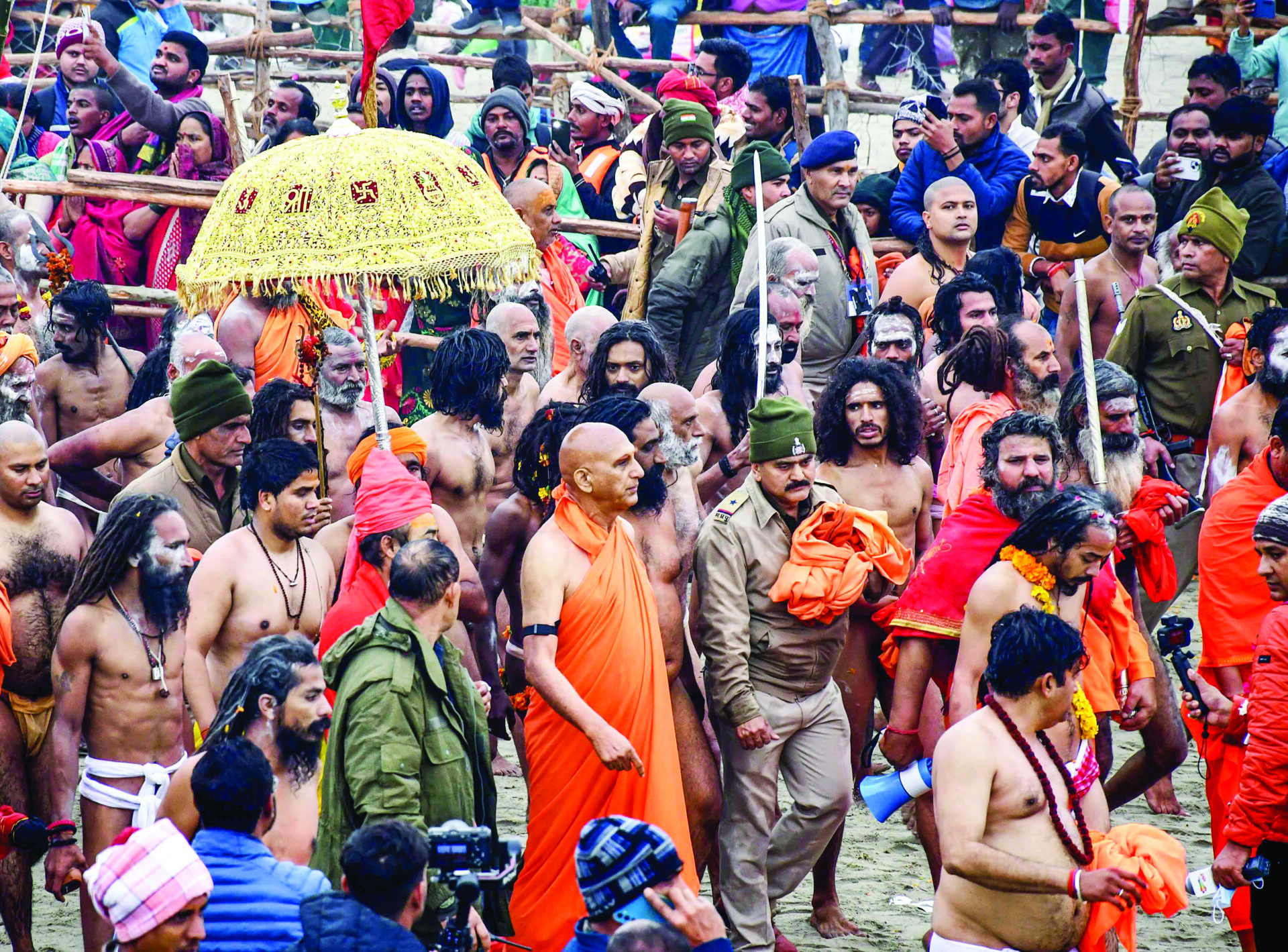Akharas are organised into sects primarily based on their philosophical beliefs and chosen deities.
The Maha Kumbh Mela is one of the largest and most significant religious gatherings in the world, attracting millions of pilgrims from India and beyond. Central to this grand event are the Akharas, ancient sects of Hindu ascetics and saints, who play a key role in the rituals and ceremonies. With their rich history and diverse traditions, the Akharas embody various streams of Hindu philosophy and practice. Far more than religious groups, they serve as guardians of centuries-old traditions, blending militant asceticism with deep spiritual teachings. Each Akhara brings its own unique identity, philosophy, and practices, adding to the vibrant and multifaceted nature of the Kumbh Mela.
At the Kumbh Mela, Akharas showcase their presence through grand processions, elaborate rituals, and the renowned Shahi Snan (Royal Bath), where they ceremonially bathe in sacred rivers. This ritual, believed to cleanse the soul and absolve sins, draws millions of devotees eager to participate in or witness the event.
Traditionally, 13 Akharas participate in the Kumbh Mela. However, during the Prayagraj Kumbh Mela in 2019, a women’s Akhara broke convention by establishing their own camp and performing ceremonies under their own flag, mirroring those of the male Akharas. This brought the total number of participating Akharas to 14. The Akharas joining the 2025 Kumbh Mela include Nirmohi Akhara, Nirvani Akhara, Digamber Akhara, Mahanirvani Akhara, Atal Akhara, Bada Udaseen Akhara, and Nirmal Akhara. Another group comprises Niranjani Akhara, Juna Akhara, Avahan Akhara, Anand Akhara, Agni Akhara, and Naya Udasin Akhara. Additionally, the Prayagraj Kumbh introduced the “Kinnar Akhada,” a female and transgender Akhara, offering a unique and remarkable experience for pilgrims.
Akharas are organised into sects primarily based on their philosophical beliefs and chosen deities. The two main categories are Shaiva Akharas, dedicated to Lord Shiva, and Vaishnava Akharas, devoted to Lord Vishnu. Each Akhara operates under a hierarchical structure led by a Mahant (chief) or Acharya (spiritual leader), who oversees its spiritual and administrative affairs. Within the Akhara, roles such as Mahamandaleshwar (high-ranking monks) hold significant influence. Members undergo rigorous training, which includes spiritual practices, meditation, scriptural study, and physical exercises like traditional Indian wrestling and martial arts.
The origins of Akharas date back to ancient times, established to preserve and promote religious and cultural practices amid foreign invasions and societal changes. Initially, they served as centres of spiritual learning and physical training, preparing members to defend the faith both intellectually and physically. Over time, they evolved into custodians of Hindu dharma and spirituality. During the mediaeval period, particularly under the threat of invasions, Akharas safeguarded temples and holy sites while providing structure for ascetics who renounced worldly life. Many were founded by influential saints and spiritual leaders, attracting followers through their teachings and exemplary lives.
Akharas are vital institutions in Hinduism, preserving ancient spiritual traditions and sacred knowledge across generations. They provide structured training for spiritual seekers, fostering discipline and self-realisation. As cultural custodians, Akharas play a prominent role in religious events like the Kumbh Mela and uphold a martial heritage, especially among Naga Sadhus. Beyond spirituality, they engage in social and charitable activities, offering education and support to the needy.
IMPORTANT AKHARAS
NAGA AKHARA: Originating in ancient times, Naga Akhara was formed to protect Hinduism during foreign invasions. Known for their militant asceticism, Naga Sadhus, often seen naked and smeared with ash, carry weapons symbolising their martial heritage. They lead the Shahi Snan at the Kumbh Mela, with grand processions showcasing their spiritual and martial traditions.
NIRANJANI AKHARA: Founded in 904 AD by Adi Shankaracharya, Niranjani Akhara upholds Advaita Vedanta and Shiva worship. Members focus on meditation, yoga, and scriptural study, emphasising detachment and inner purity. At the Kumbh Mela, they participate in the Shahi Snan and host camps for spiritual teachings and blessings.
VAISHNAVA AKHARA: Dedicated to Lord Vishnu, Vaishnava Akhara promotes Bhakti Yoga and devotional practices centred on Vishnu’s incarnations. Members engage in chanting, scripture study, and service to God. They enrich the Kumbh Mela with spiritual teachings, kirtans, and rituals, participating in the Shahi Snan.
MAHANIRVANI AKHARA: Founded in the 8th century by Adi Shankaracharya, Mahanirvani Akhara consolidates Shaiva traditions. Members follow strict ascetic practices aimed at attaining moksha. Their rituals and processions at the Kumbh Mela highlight their deep Shaiva roots.
JUNA AKHARA: Dating back to the 4th century, Juna Akhara was established by Kapil Muni and is one of the largest Akharas. Members practise yoga, meditation, and austerities to achieve enlightenment. Their grand Kumbh Mela processions, featuring sadhus, elephants, and music, mark the start of the Shahi Snan.
The Akharas play a pivotal role in the Kumbh Mela, performing rituals and ceremonies that reflect Hindu spirituality and cultural heritage. The most significant of these is the Shahi Snan (Royal Bath), a ceremonial dip in the sacred rivers during auspicious planetary alignments, believed to cleanse sins and lead to salvation. The Akharas lead grand processions to the ghats, with the ash-smeared Naga Sadhus being a prominent feature. The Peshwai procession marks the ceremonial entry of Akharas into the festival, showcasing decorated elephants, horses, and chanting saints, symbolising their readiness for the event. At their camps, daily rituals and aarti, involving prayers, hymns, and ceremonial worship, create a sacred atmosphere that draws devotees seeking blessings.
The Akharas also conduct yagna and havan, ancient Vedic fire rituals to invoke divine blessings and purify the surroundings, performed by priests on auspicious days. Discourses and teachings by saints and scholars provide pilgrims with spiritual insights into Hindu philosophy, ethics, and practices, attracting large gatherings. Initiation ceremonies (diksha) induct new members into the Akharas, marking their commitment to the ascetic path through vows and mentorship. Additionally, the Akharas and their followers perform Parikrama, circumambulating sacred sites to symbolise devotion and gain spiritual merit.

